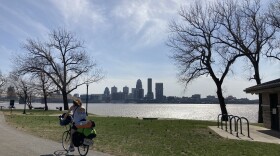The accident occurred early Tuesday when a vessel towing 11 barges hit a structure at the entrance to the Portland Canal in the Ohio River near Louisville. All but one of the barges broke free. No injuries were reported.
Salvage crews were able to pull one of the barges from the dam Wednesday morning, but two more remain pinned by the river’s current. Mayor Craig Greenberg says crews will have to wait for the water levels to go down before they can access the remaining barges.
“Safety is our number one priority. The safety of the public and the safety of the first responding team,” Greenberg said.
Kentucky’s Energy and Environment Cabinet (EEC) says the cargo included soy, corn and around 1,400 tons of methanol, a volatile, industrial chemical that can be poisonous. Salvage crews say they’ve seen damage on both the remaining barges, but so far the container holding the methanol remains intact. State officials are monitoring the air and water for impacts.
In the event of a catastrophic release, the methanol could travel as far as 15 miles downriver before diluting in the water and dissipating into the air, said Rob Blair, an environmental scientist with the EEC.
“We probably would have some impacts to aquatic life, we may see a fish kill,” Blair said.
Even in the event of a release, officials say it would not impact drinking water for Louisville, or cities farther downstream.
The water intakes for Louisville Water Company are upriver from the accident. The next closest intakes are a couple hundred miles downriver in Evansville, Indiana, and Henderson, Kentucky, which would give enough time and distance for the chemicals to dissipate.
Salvage crews don't have a firm timeline on when they’ll be able to remove the remaining barges.
This story has been updated with additional details.






